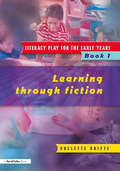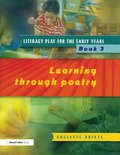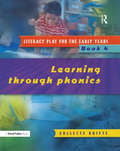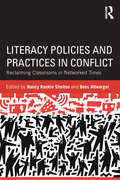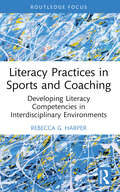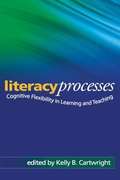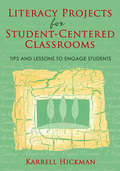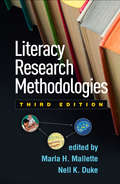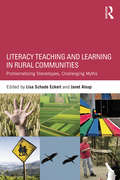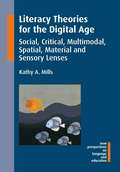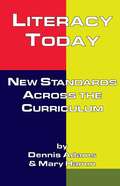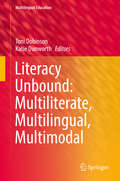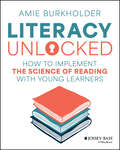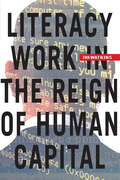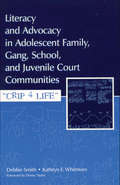- Table View
- List View
Literacy Myths, Legacies, and Lessons: New Studies on Literacy
by Harvey J. Graff Shirley Brice HeachIn his latest writings on the history of literacy and its importance for present understanding and future rethinking, historian Harvey J. Graff continues his critical revisions of many commonly held ideas about literacy. The book speaks to central concerns about the place of literacy in modern and late-modern culture and society, and its complicated historical foundations.Drawing on other aspects of his research, Graff places the chapters that follow in the context of current thinking and major concerns about literacy, and the development of both historical and interdisciplinary studies. Special emphasis falls upon the usefulness of "the literacy myth" as an important subject for interdisciplinary study and understanding. Critical stock-taking of the field includes reflections on Graff's own research and writings of the last three decades, and the relationships that connect interdisciplinary rethinking and the literacy myth.The collection is noteworthy for its attention to Graff's reflections on his identification of "the literacy myth" and in developing LiteracyStudies@OSU (Ohio State University) as a model for university-wide interdisciplinary programs. It also deals with ordinary concerns about literacy, or illiteracy, that are shared by academics and concerned citizens. These nontechnical essays will speak to both academic and nonacademic audiences across disciplines and cultural orientations.
Literacy Play for the Early Years Book 1: Learning Through Fiction
by Collette DrifteThis series of books uses fiction, non-fiction and poetry texts, as well as phonics, as a basis to help young children in the Early Years develop their literacy skills. It brings together the early learning goals of the foundation stage and the national literacy strategy objectives, using structured play, games and fun activities to put across the relevant teaching points in an enjoyable way, while simultaneously nurturing a love of literature. Each book presents structured activities based around suggested focus texts. To help practitioners save time in planning and organizing, the materials needed and the preparation required for each session are described in detail. The activities have been designed to cater to different achievement levels, and can be adapted or added to according to the needs of individual children and settings. Follow-up activities are also suggested, to bring in wider aspects of the Early Learning Goals and the NLS objectives. Elements of this book include exploring well-loved traditional stories and quality familiar modern stories by established authors; using the texts as a basis to focus on specific literacy goals and objectives; using the texts as a stimulus for games and play activities that help to teach literacy skills; planning and preparation for each literacy session, including materials needed and scripted sessions; ideas for working and playing with the whole group and smaller groups to consolidate the literacy skill; and extension ideas and activities.
Literacy Play for the Early Years Book 3: Learning Through Poetry
by Collette DrifteThis series of books uses fiction, non-fiction and poetry texts, as well as phonics, as a basis to help young children in the Early Years develop their literacy skills. It brings together the early learning goals of the foundation stage and the national literacy strategy objectives, using structured play, games and fun activities to put across the relevant teaching points in an enjoyable way, while simultaneously nurturing a love of literature. Each book presents structured activities based around suggested focus texts. To help practitioners save time in planning and organizing, the materials needed and the preparation required for each session are described in detail. The activities have been designed to cater to different achievement levels, and can be adapted or added to according to the needs of individual children and settings. Follow-up activities are also suggested, to bring in wider aspects of the Early Learning Goals and the NLS objectives. Elements of this book include exploring well-loved traditional stories and quality familiar modern stories by established authors; using the texts as a basis to focus on specific literacy goals and objectives; using the texts as a stimulus for games and play activities that help to teach literacy skills; planning and preparation for each literacy session, including materials needed and scripted sessions; ideas for working and playing with the whole group and smaller groups to consolidate the literacy skill; and extension ideas and activities.
Literacy Play for the Early Years Book 4: Learning Through Phonics
by Collette DrifteThis series of books uses fiction, non-fiction and poetry texts, as well as phonics, as a basis to help young children in the Early Years develop their literacy skills. It brings together the early learning goals of the foundation stage and the national literacy strategy objectives, using structured play, games and fun activities to put across the relevant teaching points in an enjoyable way, while simultaneously nurturing a love of literature. Each book presents structured activities based around suggested focus texts. To help practitioners save time in planning and organizing, the materials needed and the preparation required for each session are described in detail. The activities have been designed to cater to different achievement levels, and can be adapted or added to according to the needs of individual children and settings. Follow-up activities are also suggested, to bring in wider aspects of the Early Learning Goals and the NLS objectives. Elements of this book include exploring well-loved traditional stories and quality familiar modern stories by established authors; using the texts as a basis to focus on specific literacy goals and objectives; using the texts as a stimulus for games and play activities that help to teach literacy skills; planning and preparation for each literacy session, including materials needed and scripted sessions; ideas for working and playing with the whole group and smaller groups to consolidate the literacy skill; and extension ideas and activities.
Literacy Play: Over 300 Dramatic Play Activities That Teach Pre-Reading Skills
by Amy Cox Sherrie WestChildren love to pretend, and dramatic play is the perfect environment for practicing and applying literacy concepts. Whether they decide to be firefighters, to open a pet store, or to have a tea party, children will increase their vocabulary, communicate with their friends, and learn to recognize environmental print - all important skills for pre-readers. Literacy Play is chock-full of creative dramatic play activities that teach important pre-reading skills while bringing children's imaginations to life!
Literacy Policies and Practices in Conflict: Reclaiming Classrooms in Networked Times
by Nancy Rankie Shelton Bess AltwergerCurrent U.S. school reform efforts link school success, student achievement, and teacher performance to standardized tests and narrowly prescribed curricula. How do test-driven, mandated curricula in urban school systems overtly and subtly impact teachers’ efforts to provide technologically advanced, challenging classroom environments that foster literacy development for all students? How do these federal policies affect instruction at the classroom level? The premise of this book is that, in order for teachers to confront and/or counteract the pressures placed on them from these policies, it is necessary to first understand them. This book takes a close look at the tensions that exist between federal mandates and contemporary literacy needs and how those tensions impact classroom practices. Providing a clear sociopolitical overview and analysis, it combines theoretical explanations with examples from current ethnographic research. Readers are challenged to (re)consider whether meeting test performance benchmarks should be the hallmark of school success when the goal of test performance supersedes the goal of producing highly literate, productive citizens of the future.
Literacy Practices and Perceptions of Agency: Composing Identities
by Bronwyn T. WilliamsIn this book, Bronwyn T. Williams explores how perceptions of agency—whether a person perceives and feels able to read and write successfully in a given context—are critical in terms of how people perform their literate identities. Drawing on interviews and observations with students in several countries, he examines the intersections of the social and the personal in relation to how and, crucially, why people engage successfully or struggle painfully in literacy practices and what factors and forces they regard as enabling or constraining their actions. Recognizing such moments and patterns can help teachers and researchers rethink their approaches to teaching to facilitate students’ sense of agency as writers and readers.
Literacy Practices in Sports and Coaching: Developing Literacy Competencies in Interdisciplinary Environments (Routledge Research in Literacy Education)
by Rebecca G. HarperThis book addresses the ways in which literacy skills, including both reading and writing instruction, are introduced, reinforced, reviewed, and refined in a sports or physical education setting.While there has been significant research that highlights the academic benefits of sports participation and the use of sports programming and units for literacy instruction in the classroom, there is limited research regarding the literacy practices that occur as a direct part of sports participation. This book addresses this crucial gap in the scholarship. The argument presented in this manuscript contends that a number of literacy skills and competencies are taught in and through a number of sports programs and explores how they are effectively and naturally integrated into structured athletics/sports programming. Addressing engagement with literacy skills and competencies in a unique setting, it provides a new lens from which readers can view reading and writing.This book will be of critical interest to scholars and researchers with interests in literacy education and sports education, as well as instructional coaches, sports coaches, literacy educators, health and physical education teachers, middle and secondary educators, and administrators.
Literacy Practices in Transition
by Lars Holm Anne Pitkänen-HuhtaLiteracy Practices in Transition explores the connections between local, situated literacy practices and global processes of mobility in the geographical space of the Nordic countries, an example of contemporary mobile societies. The detailed empirical analyses show how these connections affect individuals, practices and policies; how the global and local meet in discourses and practices and how people need to (re)negotiate their way in the complex and messy spaces in which they move. The volume challenges current trends in the global standardization of language and literacy education. Instead, it promotes the idea of literacy as a multiple, multilingual, multimodal and constantly contestable and negotiable phenomenon, which calls for the development of language and literacy education that is sensitive to the needs and experiences of the individual actors.
Literacy Processes
by Gedeon O. Deak Kelly B. CartwrightReading and writing instruction require individuals--both students and teachers--to flexibly process many kinds of information, from a variety of sources. This is the first book to provide an in-depth examination of cognitive flexibility: how it develops across the lifespan; its role in specific literacy processes, such as phonemic awareness, word recognition, and comprehension; and implications for improving literacy instruction and teacher education. The contributors include leading researchers in literacy, psychology, and cognitive development, who summarize the current state of the science and offer practical suggestions for fostering cognitive flexibility in learners of all ages.
Literacy Projects for Student-Centered Classrooms: Tips and Lessons to Engage Students
by Karrell HickmanMeets NCTE and IRA standards, offers guidelines for using the student-centered approach to literacy instruction, and presents four long-term research projects that encourage teamwork and creativity.
Literacy Research Methodologies, Second Edition
by Marla Mallette Nell DukeThe definitive reference on literacy research methods, this book serves as a key resource for researchers and as a text in graduate-level courses. Distinguished scholars clearly describe established and emerging methodologies, discuss the types of questions and claims for which each is best suited, identify standards of quality, and present exemplary studies that illustrate the approaches at their best. The book demonstrates how each mode of inquiry can yield unique insights into literacy learning and teaching and how the methods can work together to move the field forward. New to This Edition Significantly expanded covers 18 approaches instead of 13.Incorporates the latest methodological advances and empirical findings. Chapters on content analysis, research in digital contexts, mixed methods, narrative approaches, and single-subject experimental design.
Literacy Research Methodologies, Third Edition
by Marla H. Mallette and Nell K. DukeDifferent research methods can yield unique insights into literacy learning and teaching--and, used synergistically, can work together to move the field forward. Now revised and updated with 50% new material, this definitive text presents widely used methods and provides students and researchers with a clear understanding of when, how, and why they are applied. Leading authorities describe established and emerging methodologies, review the types of questions they are suited to address, and identify standards for quality. Key issues in research design are accessibly discussed. Each chapter offers one or more exemplars of high-quality published studies to illustrate the approach in action. The benefits of using multiple types of methods to more fully investigate a given question or problem are emphasized throughout. New to This Edition *Chapter on a vital new topic: critical race methodologies. *New chapters on core topics: design-based research, causal effects, ethnographic case studies, correlational designs, discourse analysis, instrument development, and verbal protocols. *Up-to-date coverage of online research methods, neuroimaging, and other rapidly evolving methodologies. *Many of the exemplary studies are new.
Literacy Teacher Education
by Deborah G. Litt Susan D. Martin Nancy A. PlaceFew resources exist to give literacy teacher educators a comprehensive view of effective, innovative practices in their field, making this uniquely practical volume an important addition to the literature. Each chapter describes research findings and pedagogical methods, with an emphasis on what teachers really need to know to succeed. Woven into the text are more than 30 detailed activities and assignments to support teacher development, written by outstanding teacher educators. Links to professional teaching standards and the Common Core State Standards are highlighted throughout. Supplemental materials, including forms, checklists, and handouts, can be downloaded and printed in a convenient 8 1/2" x 11" size.
Literacy Teaching and Learning in Rural Communities: Problematizing Stereotypes, Challenging Myths
by Janet Alsup Lisa Schade EckertThis definitive look at teaching English in rural secondary schools contests current definitions and discussions of rural education, examines their ideological and cultural foundations, and presents an alternative perspective that conceptualizes rural communities as diverse, unique, and conducive to pedagogical and personal growth in teaching and learning. Authentic narratives document individual teachers’ moments of struggle and success in learning to understand, value, and incorporate rural literacies and sensibilities into their curricula. The teachers‘ stories and the scholarly analysis of issues raised through them illuminate the unique challenges and rewards of teaching English in a rural school and offer helpful insights and knowledge for navigating the pedagogical landscape.
Literacy Theories for the Digital Age
by Kathy A. MillsLiteracy Theories for the Digital Age insightfully brings together six essential approaches to literacy research and educational practice. The book provides powerful and accessible theories for readers, including Socio-cultural, Critical, Multimodal, Socio-spatial, Socio-material and Sensory Literacies. The brand new Sensory Literacies approach is an original and visionary contribution to the field, coupled with a provocative foreword from leading sensory anthropologist David Howes. This dynamic collection explores a legacy of literacy research while showing the relationships between each paradigm, highlighting their complementarity and distinctions. This highly relevant compendium will inspire researchers and teachers to explore new frontiers of thought and practice in times of diversity and technological change.
Literacy Through Symbols: Improving Access for Children and Adults
by Tina Detheridge Mike DetheridgeThis second edition of an important and essentially practical book is now fully updated and revised to take into account the significant developments that have been made in using symbols to support literacy. It is full of ideas and examples of the ways in which access to literacy can be enhanced through the use of symbols, based on the experience of the authors and many practitioners. Topics covered include how symbols are being used in schools, colleges and day care centers; ways in which symbols can help to enhance learning and independence; lots of new examples of good practice from practitioners; the results of the Rebus Symbol development project; how symbols fit in with the National Literacy Strategy; and how symbols can be used to make information more accessible. Teachers in mainstream and special schools, teaching assistants, day-care workers and parents should find this book helps them understand how to use symbols to improve literacy and aid communication.
Literacy Today: New Standards Across the Curriculum (Source Books on Education)
by Mary Hamm Dennis AdamsFirst Published in 2000. Routledge is an imprint of Taylor & Francis, an informa company.
Literacy Unbound: Multiliterate, Multilingual, Multimodal (Multilingual Education #30)
by Katie Dunworth Toni DobinsonThis volume promotes a thought-provoking discussion on contemporary issues surrounding the teaching of language and literacy based on first hand experiences and research. Drawing on the authors’ experiences as teacher educators, language and literacy teachers, and researchers on literacy issues it brings together the multiple traditions. What makes the proposed volume unique is the common theme that runs through all the chapters: the examination of the term literacy, the complexity of this term and the importance of having a wide understanding of what it is before tackling educational issues of pedagogy, assessment and student engagement. What is more, as the editors argue, it is necessary to join up the dots and explore the commonalities that form the core of the literacy spectrum.
Literacy Unlocked: How to Implement the Science of Reading with Young Learners
by Amie BurkholderThe latest research and most effective teaching tools for better early literacy instruction Literacy Unlocked explores the pivotal role of early literacy instruction in shaping a child's reading development and overall academic success. Shifting the focus from reactive intervention to a proactive approach that addresses problems before they arise, this book equips readers with research-backed insights and practical, accessible strategies to implement the science of reading to ensure future generations excel in literacy. Each chapter includes a link leading readers to supplementary online materials that can be utilized in instruction. Written by Amie Burkholder, K-5 literacy coach and CEO of Literacy Edventures, a popular early literacy learning platform, this book explores ideas including: The brain science of reading, with information on brain plasticity and the roles of the frontal, occipital-temporal, and parietal-temporal regions The disconnect in learning phonemic awareness and phonics separately, and why and how to address it as instructors Prerequisites for effective handwriting instruction, such as fine motor skills, pencil grip and posture, and understanding writing lines The importance of predictable routines in literacy instruction to help alleviate excessive student cognitive load, including the use of decodable texts Cutting to the crux of better literacy instruction in simple language that anyone can understand, Literacy Unlocked is an essential resource for K-5 teachers, administrators, instructional assistants, reading specialists, and literacy coaches.
Literacy Work Stations: Making Centers Work
by Debbie DillerEver wonder what the rest of your class should be doing while you are working with a small reading group? Debbie Diller offers practical suggestions in Literacy Work Stations: Making Centers Work for over a dozen literacy work stations that link to classroom instruction and make preparation and management easy for teachers. Learn how to set up work stations, how to manage them, and how to keep them going throughout the year. Each chapter includes: How to introduce each station Which materials to include at which station What to model the station as How to solve problems and differentiate How to assess while keeping students accountable Reflection questions for professional development Materials in both English and Spanish are provided in the extensive resource section. Throughout the book the author has included photos of literacy workstations from a variety of classrooms in which she has worked to illustrate the methods discussed in the text. Literacy Work Stations is a go-to classroom resource that will help you keep all students engaged while you focus in on small groups.
Literacy Work in the Reign of Human Capital
by Evan WatkinsIn recent years, a number of books in the field of literacy research have addressed the experiences of literacy users or the multiple processes of learning literacy skills in a rapidly changing technological environment. In contrast to these studies, this book addresses the subjects of literacy. In other words, it is about how literacy workers are subjected to the relations between new forms of labor and the concept of human capital as a dominant economic structure in the United States. It is about how literacies become forms of value producing labor in everyday life both within and beyond the workplace itself.As Evan Watkins shows, apprehending the meaning of literacy work requires an understanding of how literacies have changed in relation to not only technology but also to labor, capital, and economics. The emergence of new literacies has produced considerable debate over basic definitions as well as the complexities of gain and loss. At the same time, the visibility of these debates between advocates of old versus new literacies has obscured the development of more fundamental changes. Most significantly, Watkins argues, it is no longer possible to represent human capital solely as the kind of long-term resource that Gary Becker and other neoclassical economists have defined. Like corporate inventory and business management practices, human capital—labor—now also appears in a “just-in-time” form, as if a power of action on the occasion rather than a capital asset in reserve.Just-in-time human capital valorizes the expansion of choice, but it depends absolutely on the invisible literacy work consigned to the peripheries of concentrated human capital. In an economy wherein peoples’ attention begins to eclipse information as a primary commodity, a small number of choices appear with an immensely magnified intensity while most others disappear entirely. As Literacy Work in the Reign of Human Capital deftly illustrates, the concentration of human labor in the digital age reinforces and extends a class division of winners on the inside of technological innovation and losers everywhere else.
Literacy Workshop: Where Reading and Writing Converge
by Maria Walther Karen Biggs-TuckerThe Literacy Workshop: Where Reading and Writing Converge is a first-of-its-kind resource that offers a practical process for creating an integrated literacy workshop using demonstration lessons that align with current curriculum standards. In this forward-thinking book, authors Maria Walther and Karen Biggs-Tucker share what they've learned over countless reading and writing workshops and combine into one literacy workshop. The authors demonstrate how you can save valuable classroom time while still empowering students to uncover exciting connections in their learning – leading to stronger, more motivational readers and writers. By weaving the common threads of literacy learning together, you can increase the time your students spend engaged in authentic reading and writing. Inside you'll find the following: A clear, succinct explanation of the literacy workshop structure, how to get started, and how to determine the best time to begin the merge; 50+ demonstration lesson plans, appropriate for both primary and intermediate grade levels, that use strategies incorporating elements from recommended fiction and nonfiction anchor texts; Substantial, printable resources and online tools to help make this instructional shift as smooth as possible. From the big picture to small, helpful details, The Literacy Workshop will be your guide as you blur the lines between your reading and writing workshops - creating space for students to apply their learning and practice the habits, behaviors, and actions of literate and engaged citizens.
Literacy and Advocacy in Adolescent Family, Gang, School, and Juvenile Court Communities: Crip 4 Life
by Kathryn F. Whitmore Debra SmithThe goal of this book is to encourage educators and researchers to understand the complexities of adolescent gang members' lives in order to rethink their assumptions about these students in school. The particular objective is to situate four gang members as literate, caring students from loving families whose identities and literacy keep them on the margins of school. The research described in this book suggests that advocacy is a particularly effective form of critical ethnography. Smith and Whitmore argue that until schools, as communities of practice, enable children and adolescents to retain identities from the communities in which they are full community members, frightening numbers of students are destined to fail.The stories of four Mexican American male adolescents, who were active members of a gang and Smith's students in an alternative high school program, portray the complicated, multiple worlds in which these boys live. As sons and teenage parents they live in a family community; as CRIP members they live in a gang community; as "at risk" students, drop-outs, and graduates they live in a school community, and as a result of their illegal activities they live in the juvenile court community. The authors theorize about the boys' literacy in each of their communities. Literacy is viewed as ideological, related to power, and embedded in a sociocultural context. Vivid examples of conversation, art, tagging, rap, poetry, and other language and literacy events bring the narratives to life in figures and photographs in all the chapters. Readers will find this book engaging and readable, yet thought provoking and challenging.Audiences for Literacy and Advocacy in Adolescent Family, Gang, School, and Juvenile Court Communities include education researchers, professionals, and students in the areas of middle/high school education, at-risk adolescent psychology, and alternative community programs--specifically those interested in literacy education, sociocultural theory, and popular culture.
Literacy and Bilingualism: A Handbook for ALL Teachers (2nd Edition)
by Maria Estela Brisk Margaret M. HarringtonThis handbook applies proven techniques, derived from bilingual/bicultural classrooms, to teaching literacy in the twenty-first century. Its goal is to help teachers increase their understanding of bilingual learners in order to maximize instruction. Teachers can use this handbook to expand their understanding of literacy and bilingualism; implement literacy approaches and assess students’ development; and learn through reflection. Practical, flexible format and content. Complete and straightforward instructions, illustrated by case studies, allow teachers to use the strategies in this handbook on their own or in teacher-led study groups. They can select from the variety of approaches the ones which best match their students’ needs and their own teaching style. Student-centered focus. All of the approaches share characteristics that help motivate students of varying language abilities to develop literacy. Field-tested approaches. The approaches have been modified and tested with bilingual students of different ages and language backgrounds in bilingual, ESL, mainstream, special education, and deaf education classes ranging from preschool through high school. New in the Second Edition: *five new approaches with their corresponding classroom implementation;*additional information in each introduction addressing its theme;*new material on issues of language, culture, and literacy development of students completely new to the English language; and*annotated bibliographies with sample books to support literacy within language and content area classes. Literacy and Bilingualism is intended for a broad audience of teachers in any type of classroom where bilingualism plays a role, and is an excellent text for preservice and inservice courses that prepare teachers to work with English language learners.

